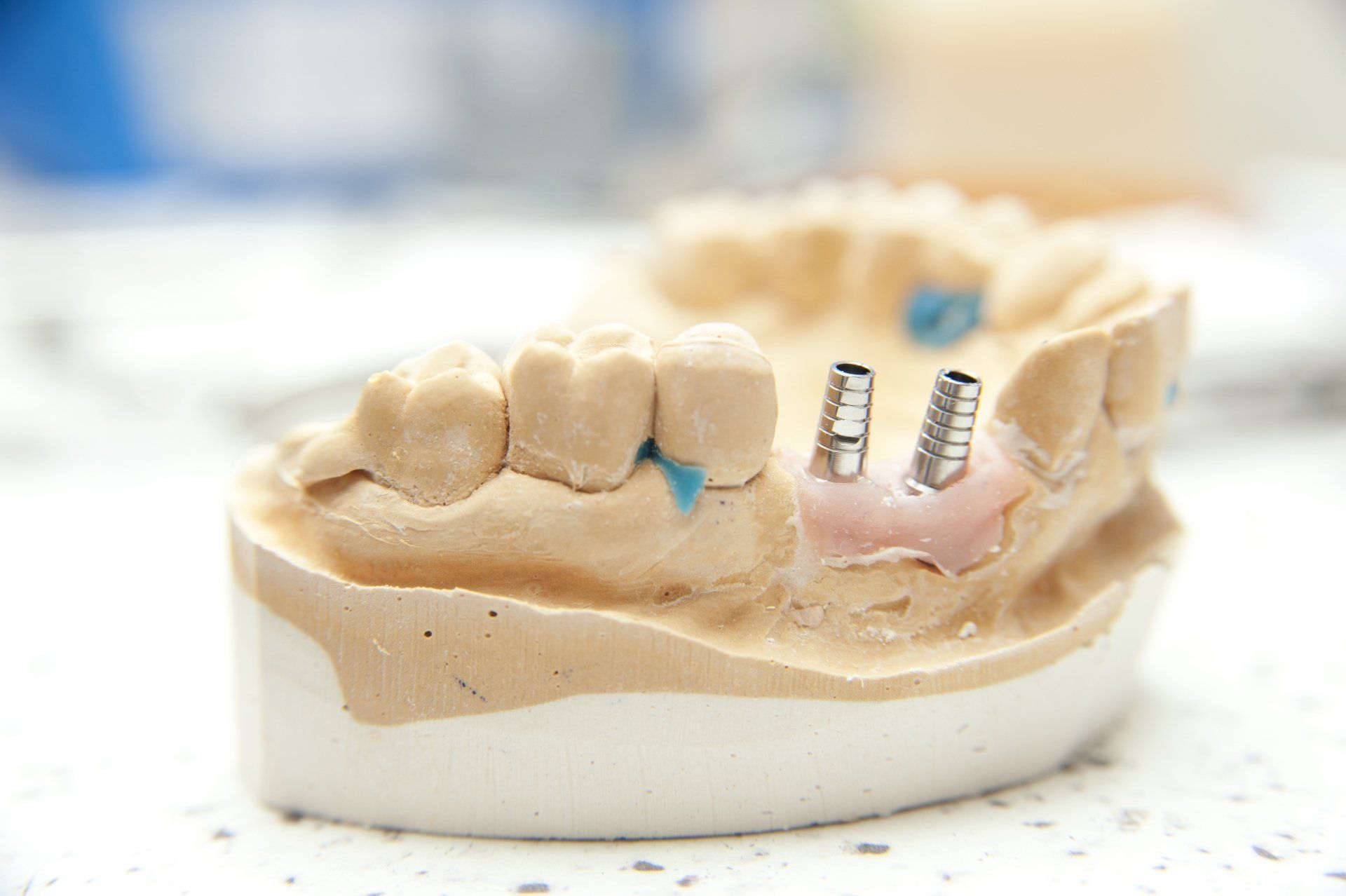Address: 1706 N Main St High Point, NC 27262
Call Us! 336-884-4000
Email: amoore18@msn.com
Address: 1706 N Main St High Point, NC 27262
Email: amoore18@msn.com
Call Us! 336-884-4000
Cosmetic Dentistry
In the past decade there has been a dramatic interest in cosmetic dentistry. We all realize that having a healthy, bright, beautiful smile enhances our appearance and allows us to smile with confidence. Thanks to the advances in modern cosmetic dentistry, we can improve our teeth and smiles with quick, painless and surprisingly affordable treatments.
Cosmetic dental treatments can:
• Change the size, shape, and alignment of certain teeth.
• Fill in unattractive spaces between teeth.
• Improve or correct bites.
• Lighten or brighten the color of teeth.
• Repair decayed, broken, cracked, or chipped teeth.
• Replace missing teeth.
• Replace old, unattractive dental treatments.
Remember, your smile speaks before you even say a word!
-
Same Day Crowns (CEREC®)
Same day crowns of Esthetic Ceramic (CEREC®) have revolutionized dental procedures. Traditionally, if crowns, onlays, inlays or dental veneers were required to restore damaged teeth, multiple procedures, and a great deal of waiting time in-between would be inevitable. CEREC® creates these ceramic restorations within minutes in the dental office. This means that many treatments can be completed in just a single visit.
CEREC® is comprised of several computer-assisted design (CAD) tools and a milling machine that creates custom ceramic restorative devices. Same day crowns can benefit almost anyone needing a ceramic restoration. This is of great benefit to nervous patients, and it can also reduce the cost of treatment.
Additional advantages associated with CEREC® include:
• No temporary restorations
• High-quality ceramic products
• Minimal invasiveness
• Less injections and discomfort
• Fewer dental visits
• Cost effectiveness
• More natural tooth is saved
• Long lasting restorations
• Biocompatible solutions
What is the CEREC® system comprised of?
The CEREC® System is sometimes called a CAD-CAM system. CAD-CAM means Computer Assisted Design and Computer Assisted Milling. The CEREC® system has three major components:
Acquisition device: This device is home to a high-quality camera and a medical grade computer. The function of this unit is to photograph the prepared tooth. Three-dimensional images are created of the tooth on the screen, which the dentist uses to design the perfect ceramic restoration.
Three-dimensional CAD software: This software allows the dentist to examine the tooth from every angle. It is the closest possible thing to holding the tooth in the hands and rotating it.
Milling device: This unit manufactures the custom restoration from the specifications entered into the computer. A ceramic block that best resembles the existing tooth color is chosen and placed into the unit. Within minutes, the milling device produces the restoration the dentist designed.
What does a CEREC® restoration procedure involve?
The first step in the procedure is to scan the area we are restoring along with your opposing teeth and bite. Once the scans have been completed, we will then prepare your tooth for the same day crown. Once the tooth is prepared, we will then rescan the area we are restoring, sending a three-dimensional, colored model to the CEREC® machine.
These images are transposed onto the computer screen, where the dentist will view the tooth from every angle and design the final restoration. When the design is complete, it will be transmitted to the milling unit.
The dentist will insert a block of ceramic, matching your tooth color, into the milling machine which will then create the full crown, onlay, inlay, or veneer. Before affixing the restoration to the tooth, the dentist will perform a dry fit to ensure comfort. Once a perfect fit is established, the restoration will be polished and affixed to the tooth with dental cement.
If you have questions about CEREC® or would like to obtain more information on this innovative technology, please contact our office.
-
Composite Fillings
A composite (tooth colored) filling is used to repair a tooth that is affected by decay, cracks, fractures, etc. The decayed or affected portion of the tooth will be removed and then filled with a composite filling.
There are many types of filling materials available, each with their own advantages and disadvantages. You and your dentist can discuss the best options for restoring your teeth. Composite fillings, along with silver amalgam fillings, are the most widely used today. Because composite fillings are tooth colored, they can be closely matched to the color of existing teeth and are more aesthetically suited for use in front teeth or the more visible areas of the teeth.
As with most dental restorations, composite fillings are not permanent and may someday have to be replaced. They are very durable, and will last many years, giving you a long lasting, beautiful smile.
Reasons for composite fillings:
• Chipped teeth.
• Closing space between two teeth.
• Cracked or broken teeth.
• Decayed teeth.
• Worn teeth.
How are composite fillings placed?
Composite fillings are usually placed in one appointment. While the tooth is numb, your dentist will remove decay as necessary. The space will then be thoroughly cleaned and carefully prepared before the new filling is placed. If the decay was near the nerve of the tooth, a special medication will be applied for added protection. The composite filling will then be precisely placed, shaped, and polished, restoring your tooth to its original shape and function.
It is normal to experience minor sensitivity to hot and cold when composite fillings are first placed, however this will subside shortly after your tooth acclimates to the new filling.
You will be given care instructions at the conclusion of your treatment. Good oral hygiene practices, eating habits, and regular dental visits will aid in the life of your new fillings.
-
Porcelain Fixed Bridges
A dental bridge is a fixed (non-removable) appliance and is an excellent way to replace missing teeth.
There are several types of bridges. You and your dentist will discuss the best options for your case. The “traditional bridge” is the most popular type and is usually made of porcelain fused to metal. Porcelain fixed bridges are most popular because they resemble your natural teeth. This type of bridge consists to two crowns that go over two anchoring teeth (abutment teeth) and are attached to pontics (artificial teeth), filling the gap created by one or more missing teeth.
Dental bridges are highly durable and will last many years, however they may need replacement or need to be re-cemented due to normal wear.
Reasons for a fixed bridge:
• Fill space of missing teeth.
• Maintain facial shape.
• Prevent remaining teeth from drifting out of position.
• Restore chewing and speaking ability.
• Restore your smile.
• Upgrade from a removable partial denture to a permanent dental appliance.
What does getting a fixed bridge involve?
Getting a bridge usually requires two or more visits. While the teeth are numb, the two anchoring teeth are prepared by removing a portion of enamel to allow for a crown. Next, a highly accurate impression (mold) is made which will be sent to a dental laboratory where the bridge will be fabricated. In addition, a temporary bridge will be made and worn for several weeks until your next appointment.
At the second visit, your permanent bridge will be carefully checked, adjusted, and cemented to achieve a proper fit. Occasionally your dentist may only temporarily cement the bridge, allowing your teeth and tissue time to get used to the new bridge. The new bridge will be permanently cemented later.
You will receive care instructions at the conclusion of your treatment. Proper brushing, flossing and regular dental visits will aid in the life of your new permanent bridge.
-
Porcelain Veneers
Veneers are very thin pieces of durable, tooth shaped porcelain that are custom made (for shape and color) by a professional dental laboratory. They are bonded onto the front of teeth to create a beautiful and attractive smile.
Veneers can completely reshape your teeth and smile. They can often be alternatives to crowns and the ideal solution in treating many dental conditions.
As with most dental restorations, veneers are not permanent and may someday need replacement. They are very durable and will last many years, giving you a beautiful long-lasting smile.
Reasons for porcelain veneers:
• Cosmetically, to create a uniform, white, beautiful smile.
• Crooked teeth.
• Misshapen teeth.
• Severely discolored or stained teeth.
• Teeth that are too small or large.
• Unwanted or uneven spaces.
• Worn or chipped teeth.
What does getting porcelain veneers involve?
Getting veneers usually requires two visits to complete the process, with little or no anesthesia required during the procedure. The teeth are prepared by lightly buffing and shaping the surface to allow for the thickness of the veneer. A mold or impression of the teeth is taken and a shade (color) will then be chosen by you and the dentist.
On the second visit the teeth will be cleansed with special liquids to achieve a durable bond. Bonding cement is then placed between the tooth and veneer and a special light beam is used to harden and set the bond.
You will receive care instructions for veneers. Proper brushing, flossing and regular dental visits will aid in the life of your new veneers.
-
Tooth Whitening
Tooth whitening (or bleaching) is a simple, non-invasive dental treatment used to change the color of natural tooth enamel and is an ideal way to enhance the beauty of your smile. It is the most popular cosmetic procedure available today.
Because having whiter teeth has now become the number one aesthetic concern of most patients, there are several ways to whiten teeth. The most popular method is using a home tooth whitening system that will whiten teeth dramatically. Since tooth whitening only works on natural tooth enamel, it is important to evaluate replacement of any old fillings, crowns, etc. Replacement of any restorations will be done after bleaching so they will match the newly bleached teeth.
Tooth whitening is not permanent. A touch-up maybe needed after several years, and more often if you smoke, drink coffee, tea, or wine.
Reasons for tooth whitening:
• Fluorosis (excessive fluoridation during tooth development).
• Normal wear of outer tooth layer.
• Stained teeth due to medications (tetracycline, etc.).
• Yellow, brown stained teeth.
What does tooth whitening involve?
This type of tooth whitening usually requires two visits. At the first appointment, impressions (molds) will be made of your teeth to fabricate custom, clear plastic, trays.
At your second appointment, you will try on the trays for proper fit, and adjustments will be made if necessary. The trays are worn with special whitening solution either twice a day for 30 minutes or overnight for a couple of weeks depending on the degree of staining and desired level of whitening. It is normal to experience tooth sensitivity during the time you are whitening your teeth, but it will subside shortly after you have stopped bleaching.
You will receive care instructions for your teeth and trays and be encouraged to visit your dentist regularly to help maintain a beautiful, healthy, white smile.
-
Dental Implants in High Point
A dental implant is an artificial tooth root that a dentist places into your jaw to hold a replacement tooth or bridge. Dental implants in High Point NC are an ideal option for people in good general oral health who have lost a tooth or teeth due to periodontal disease, an injury, or some other reason. Check out the video section for animated explanation.
While high-tech in nature, dental implants are more tooth-saving than traditional bridgework since implants do not rely on neighboring teeth for support.
Dental implants in High Point NC are so natural-looking and feeling, you may forget you ever lost a tooth. You know that your confidence about your teeth affects how you feel about yourself, both personally and professionally. Perhaps you hide your smile because of spaces from missing teeth. Maybe your dentures don't feel secure. Perhaps you have difficulty chewing. If you are missing one or more teeth and would like to smile, speak, and eat again with comfort and confidence, there is good news! Dental implants are teeth that can look and feel just like your own! Under proper conditions, such as placement by a dentist and diligent patient maintenance, implants can last a lifetime. Long-term studies continue to show improving success rates for implants.
Dental implants in High Point NC are used to:
1. replace single tooth
2. replace multiple missing teeth (implant teeth or bridge)
3. hold denture in place
4. any of the above combination
Dental implants have been in use for over 30 years and are constantly being improved. Technological advances in implant dentistry have helped hundreds of our patients to regain lost function and aesthetics.
Dental Implants
Dental implants in High Point NC are a great way to replace missing teeth and provide a fixed solution to having removable partial or complete dentures. Implants provide excellent support and stability for these dental appliances.
Dental implants are artificial roots and teeth (usually titanium) that are surgically placed into the upper or lower jawbone. The teeth attached to implants are very natural looking and often enhance or restore a patient’s smile! Here at High Point Smile our doctors are trained in placing dental implants and maintain their training with yearly Continuing education.
Dental implants are strong and durable and will last many years. On occasion, they will have to be re-tightened or replaced due to normal wear.
Reasons for dental implants:
• Replace one or more missing teeth without affecting adjacent teeth.
• Resolve joint pain or bite problems caused by teeth shifting into missing tooth space.
• Restore a patient’s confident smile.
• Restore chewing, speech, and digestion.
• Restore or enhance facial tissues.
• Support a bridge or denture, making it more secure and comfortable.
• What does getting dental implants involve?
• The process of getting dental implants in High Point NC requires several visits over 3-4 months.

X-rays and impressions (molds) are taken of the jaw and teeth to determine bone, gum tissue, and spacing available for an implant. While the area is numb, the implant will be surgically placed into the bone and allowed to heal and integrate itself for up to 3-4 months. Depending on the type of implant, a second surgery may be required to place the “post” that will hold the artificial tooth in place. With other implants the post and anchor are already attached and placed at the same time.
After 3-4 months of healing the artificial teeth are made and fitted to the post portion of the anchor. After a healing period, the artificial teeth are securely attached to the implant, providing excellent stability and comfort to the patient.
You will receive care instructions when your treatment is completed. Good oral hygiene and eating habits, alongside regular dental visits, will aid in the life of your new implant.
If you have questions about dental implants in High point NC or would like to schedule a consultation, please contact our office.
QUICK LINKS
CONTACT INFORMATION
Address: 1706 N Main St High Point, NC 27262
Phone: 336-884-4000
Business Fax Number: 336-884-4060
Email: amoore18@msn.com
CERTIFICATION
Certified Chao Pinhole Technique
BUSINESS HOURS
Monday – Thursday 8:00 – 5:00
PAYMENT OPTIONS






